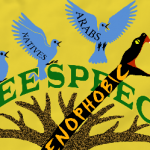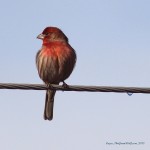First of all, thank you to everyone for your diversity of responses on my last post, We Do Not Return to Nature. We Are Already There. And especial thanks to John for his thoughtful response post and the continuing discussion there. The issues of urban sustainability and the overall human infrastructure are things that I feel deserve more attention, both in relation to spirituality and connections, and in the broader discourse of the human condition. (Or, in short, “this is important, y’all”.)
I feel I didn’t make myself entirely clear, despite my best efforts, and so I want to pull out a few ideas for further elaboration and clarification. These are in no particular order, and are more a series of rambling talking points than a cohesive essay.
–I feel it was assumed that because I was only speaking of non-human entities as connections in this ecosystem, that that is all I was discussing, as though these living beings were a lifeline to a more “pure”, non-human nature. That is not so, and I want to make that clear right now. I brought up the maple tree and the scrub jays because they are fellow living creatures that have adapted to this urban ecosystem, and I thought they might be easier for readers to relate to. However, I also learn from the buildings and the pavement and how they change (and are changed by) both the microclimate and the weather, as well as affect the larger systems of waterways, animal migration routes, erosion, and so forth. I call cities ecosystems because they are supports of a network of living beings, and non-living land masses, some of which are human-created.
–Humans are animals. Our cities and other creations may be unique, and our ability to both conceptualize and create may be wholly unlike anything else achieved by any other known species on this planet. But they are still created by humans, and I feel it is divisive and dis-connecting to think of humans and our creations as “not natural”. It is in part our perception that we are separate from nature that has caused many people to ignore the impact we have on the rest of the world, because we feel we don’t have to pay attention–it’s “not our problem”, or so we think. So many people have no idea where, for example, their food comes from. If we recreate the story of the city to include how it is connected to other ecosystems, we start rebuilding those perceptions of connections that have never entirely gone away, and we can then foster more responsibility all around. But as long as we keep telling people that cities are dis-connected from the rest of nature, they’re going to keep acting like it–and we see where that’s gotten us all.
–Telling urban dwellers that they’re bad people for living in cities, or that they can’t be as good a bunch of environmentalists as rural people, or otherwise playing who’s superior to whom, is counterproductive. Insulting someone or insinuating that you’re better than they are is a great way to alienate them. Not a good idea with potential allies. If you assume that cities are full of people who are self-centered, materialistic, corrupted, etc. then you’ve already started on the path to alienating them. Same thing with assuming all rural areas are full of nothing but small-minded hyper-conservative bigots. And so forth.
–There are crappy things about both cities and rural areas. I am fully aware of the negative impacts of cities as they currently are constructed and run, as well as the greater issues of human overpopulation, resource mismanagement, and environmental degradation. However, I do have to thank Pashy for pointing out that rural areas still do benefit from the harmful infrastructures that also support cities–over the road trucking and other non-sustainable resource transport, fossil fuels, commercialized agriculture by way of Monsanto and Archer Daniels Midland and the like, and so forth. Neither cities nor rural areas in the US (with very, very few and very small exceptions) are self-contained pods where all the food, water, shelter, electricity, and heat come from closed-circuit, sustainable sources, and I’ve yet to see a rural area that didn’t have some form of landfill or other waste disposal and that didn’t consume plastics and other non-biodegradables. All of us are contributing to the problems, one way or another, all communities of all sizes have people working toward sustainability, and the solution is not to demonize one form of living over another, but to entirely rework the entire human infrastructure to a sustainable point.
–There are also good things about both cities and rural areas. There are restorative properties to wilderness places that are unique to them, wholly unlike anything found in cities; even I head out to the Gorge frequently for refreshers. The country is a lot quieter, auditorily and otherwise. Trees and other living beings can make urban areas more comfortable and friendly places to be. Cities offer a wider variety of people on average, and so can offer more support to some minorities (depending on the city and the area), and more people means more human resources available for problem-solving and large-scale manufacturing of things like medications. Every community, large or small, has its own personality, and some of these are nicer than others regardless of population size. We have good things we can learn from all human communities, and these are great starting points for fixing the rest.
–We have seven billion people on the planet. This is not likely to change any time soon without a severe epidemic, drought, comet, etc., and a longer-term de-population involves a lot of education, availability of and education about the use of birth control, changes in attitudes toward population and repopulation, improvements in the general lot of women worldwide, and a whole slew of other things that will take a LONG time to change. So for the time being we have to figure out where to put all these people. Just spreading us out isn’t the answer. Many non-human species rely on places far away from even a few humans to be happy, and will avoid even the most sparsely human-populated areas. If we dispersed all seven billion of us into rural areas, each with acreage, we would be so spread out that many more species would feel too crowded. Most people lack skills to be able to live off the land, and that’s not going to change quickly. So for many reasons, we do need cities as places to concentrate a large portion of the human population.
–This is why I am a huge supporter of reworking human communities of ALL sizes to a sustainable model, such as those proposed in Green Metropolis. There are ways to address issues of overcrowding, pollution, social injustice, and other problems inherent to all human infrastructure. Cities can be made so that they are more walkable to cut down on the need for fossil fuel transportation; manufacturing and other resource production can be localized to avoid the long-distance transport that all communities, large or small, rely on. Public transit can be improved in rural areas so that not everyone has to have their own car to drive twenty miles to a grocery store or drive in to work five days a week. As to social justice? While there is certainly bigotry everywhere, I know that I have found it easier to find support as a queer, progressive, pagan person in cities where I am more likely to find people who support and agree with me than in conservative small towns, though certainly there are more progressive small communities as well. So we look at ways that minorities in both cities and rural areas have survived and thrived, to create a more socially sustainable human infrastructure across the board.
–So. Restating my main point after all these varied and scattered thoughts: To change the human infrastructure overall for the better, we first have to reclaim the most obvious manifestations of it–cities. And it all starts with our perceptions of them. If we perceive them as blights, then we abandon them to their fates, and they just get worse and worse. If we perceive them as just another part of nature, albeit one that is heavily and uniquely human-dominated, then we start the shift back to seeing us and what we create as connected to everything, and increase our sense of responsibility to the All.
Please, if something seems unclear, ask me for clarification rather than making assumptions.















